by Joy Livingwell
Before healing land, we must assess its current health, just as a doctor examines you and asks about your symptoms before starting treatment. Like the doctor, we want to know what's happening now, and what's possible for our "patient".
Diagnosing landscapes well takes knowledge and practice. If you want to go beyond this basic guide, I recommend Charlie Orchard's Land EKG.
Thomas J. Elpel 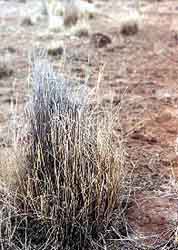 As landscape detectives, what can we learn here? 1. The few surviving plants suggest this was once a grassland. 2. The gray, dead parts on this grass tell us this landscape is brittle. (In a nonbrittle climate, dead leaves would rot, not weather.) 3. Bare ground and no young grasses tell us that the ecosystem processes that once created a grassland no longer function. |
It's important to measure landscape condition in ways that help us pick treatments that work. We can start by asking
- What used to be here when the ecosystem was healthy (or healthier)?
- How brittle is the landscape? Nonbrittle areas have constant moisture and rapid decay; brittle areas have long dry periods and slow decay.
- How well do basic ecosystem processes function?
- What happens underground? Many vital ecosystem processes take place mainly beneath the soil surface.
Taken together, these help us estimate the current carrying capacity of the land (how much wildlife or livestock it can support), and what might be possible here once the land is healthy. Even when we choose not to return the land to its original condition (we might want pasture or crops where forest once stood), we can use landscape assessment to help us produce the healthiest possible outcome.
What used to be here?
Especially when a landscape has become severely degraded, what used to be here is often our best guide to what's possible. To determine approximately what an area used to be like,
- Look for clues in the existing landscape. Areas of desert brush or bare ground may harbor a few old, half-dead perennial grasses. Look carefully; they might be very small.
- Look for remnants of the former landscape. In the central U.S.A., the soil of old graveyards is often 2-5 feet (0.6-1.5 m) deeper than on surrounding plowed land, and may harbor plants and wildlife not found elsewhere.
- Ask long-time residents. Older residents remember when the skies around Sebastopol, California used to be black with ducks during migration. Now a few dozen visit the lagoon each year.
- Read old accounts of the land. The desert around Salt Lake City, Utah, U.S.A. had grass high enough to touch a horse's belly when the Mormon settlers arrived in 1847. Writing in 440 B.C.E., Herodotus praised Libya for its deep black soils and abundant springs. Now the region is largely lifeless desert.
- Examine the archeological evidence. Ruins of ancient cities grace areas that today can support few people. Rock art may show extinct wildlife.
- Check the fossil record. About 75% of North and South America's larger wildlife (wolf-size and larger) went extinct when human hunters arrived around 11,500 years ago. Similar extinctions occurred with the arrival of modern humans in Europe, and Australia. Before that, these areas resembled East Africa in their diversity of big game. Extremely diverse ecosystems are very biologically productive.
- Compare with similar landscapes in similar climates. This is a decent way to estimate potential biological productivity if no intact examples of your ecosystem remain.
Joy Livingwell  Until humans arrived, North Americas' fauna was extremely diverse. Species that went extinct include horses, asses, camels, llamas, lions, cheetahs, giant ground sloths, sabercats, and mammoths. This glyptodont was 2.7 meters (9 feet) long. |
How brittle is the landscape?
A healthy desert and a healthy rain forest function differently, even though birth, growth, death, and decay take place in both. One of the main differences is brittleness. The rain forest is nonbrittle: the humidity is high all the time, and biological decay takes place very fast. The desert is brittle: long dry periods stop decay, so dead plant material can stand or lie on the ground for years without decaying. Most areas lie somewhere between these extremes.
Brittleness refers to fluctuations in moisture level, not rainfall. Some cloud forests receive little rain, yet are humid all year and therefore nonbrittle. Other areas receive lots of rain, but because of long dry periods are brittle.
Brittle and nonbrittle areas respond differently to management. Managing brittle land with methods that work fine in nonbrittle areas is a leading cause of desertification worldwide.
John Mix Stanley, circa 1855  Large herds of grazing animals occur only in brittle and semi-brittle areas, where nature uses them as living mulchers and composters. "Herd of Bison near Lake Jessie" North Dakota, U.S.A. |
In brittle areas, nature depends on large grazing animals to recycle plant materials. Their digestive systems are the only places that stay moist enough for microorganisms to keep working year-round. What these grazers don't eat, they trample, creating a natural mulch that protects the soil from erosion and drying.
About 70% of Earth's land is at least partly brittle. In these areas, removing grazing animals can cause temporary recovery in overgrazed plants. But the long-term effect is damage and desertification, because without grazers, nature has no way to recycle nutrients or mulch the soil.
 Rest in a nonbrittle environment. Maya ruins in southern Mexico. |
Signs of a nonbrittle landscape
- Always humid while above freezing
- Dependable moisture throughout the year
- In most years rainfall is close to average
- Rapid biological decay; dead growth rots from the bottom and falls over
- Rested land heals from damage (bare ground returns to forest)
- Unclumped grasses, closely spaced
- Heavy overgrazing produces tight plant cover in a near monoculture, resembling a lawn; small bare areas may develop near points of extreme concentration
- Few big herbivores that are solitary or live in small bands (tapir, okapi, gorilla, moose)
- Solitary predators (tigers, cougars)
Peter Donovan  Total rest in a brittle environment. This grassland in northeast Oregon, U.S.A., has not had any livestock or significant concentrations of grazing animals on it since the 1970s. |
Signs of a brittle landscape
- Long dry periods
- The year is divided into wet and dry seasons
- Rainfall is often far above or far below average
- Slow decay by weathering at the tips of twigs and grasses; dead growth may stand for years or decades
- Rest damages and desertifies land; animal impact (the intense trampling and dunging of animals in a tight herd) heals it
- Strongly clumped grasses, often widely spaced
- Heavy overgrazing produces bare ground between plants, but plant spacing is controlled mainly by amount of animal impact
- Many big herbivores forming large herds (bison, wildebeest, zebra)
- Pack-hunting predators (lions, wolves)
How well do basic ecosystem processes function?
The four ecosystem processes most useful for assessing landscape health are:
- Water cycle: What happens to water in this landscape?
- Mineral cycle: What nutrients are present? Are they in forms living things can use?
- Energy flow: Is sunlight energy getting captured by green plants and turned into food, or wasted?
- Succession: What lives here? Are populations stable, growing, or shrinking? Do many species live here, or only a few?
Water cycle
What's important is not total rainfall, but effective rainfall. How much of the water here actually supports life?
Damaged water cycle is a main cause of land degradation. The amount of water lost is astonishing. If just half a yearly rainfall of 750 mm (30 inches) evaporates or runs off, every hectare loses 521,640 liters (55,807 gallons per acre). Many areas lose 95% of their water almost instantly. A drought is insignificant compared to a damaged water cycle.
Mineral cycle
How many of the minerals here actually support life? In a healthy landscape, minerals stay in living things, and in the root zone of soils where plants and microorganisms can use them. In an unhealthy landscape, minerals get trapped in standing dead vegetation, leached below the root zone where plants can't get them, or lost to erosion or burning.
Energy flow
Joy Livingwell 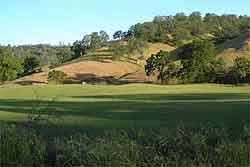 Deep roots on these green perennial grasses let them find water far into California's rainless summers. By capturing summer sunlight, they grow 3-10 times more high-quality forage than the annuals on the hills. Article |
The more sunlight energy gets captured by plants, the more food they grow for themselves and other organisms. Energy flow increases when
- More ground gets covered by living plants.
- The growing season lengthens. This might happen when the soil holds moisture better, or when perennial plants replace annuals.
- A mix of plants captures energy efficiently throughout the growing season.
- Broad-leaved plants that can capture more sunlight energy replace narrow-leaved plants.
Succession
Succession is the process by which bare rock or sand eventually becomes covered with soil and vegetation. Succession rises to the highest level an environment will support.
It's useful to think of succession as a spring that tries to rebound when compressed. When we plow a former forest or grassland, pushing the succession level down, nature pushes back, colonizing the bare soil with hardy pioneer plants we call weeds. It takes human effort to keep the succession level unnaturally low.
Assessing ecosystem function
What you see in a healthy ecosystem depends on partly on brittleness and rainfall. In very arid areas plants may always have space between them due to limited moisture, but a healthier ecosystem will have more of the soil surface covered.
Dan Dagget 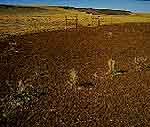 Bare ground isn't always bad. In a test of animal impact, this 2 ha (5 acre) test plot got repeated "nuked" with up to 1,000 cattle, with very long rest periods.
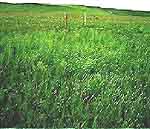 Trampling planted seeds; dung fertilized them. Result: lusher growth than outside the fence.
|
To start, take a general look at the landscape:
- Are there any obvious gullies or signs of erosion?
- What would a raindrop hit? Try to estimate the relative area of
- Living leaves (good)
- Dead leaves and litter (dead plant material on the soil surface, good for long-term ecosystem health)
- Bare ground (bad unless trampling is planting seeds)
- Is there space between plants? How much? (Less is good.)
- What kinds of plants are present? Are they annuals or perennials, grasses, forbs (commonly called weeds), shrubs, or trees? Perennials and a variety of plant types generally indicate higher succession levels.
- Are young plants succeeding? Old plants that can't reproduce will die out eventually.
- How many species are present? Diversity is good. I once counted 73 species of plants in a square meter of a never-plowed Kansas prairie. Some roadsides nearby had one plant species per square meter: brome grass.
- What species are present? Most "weeds" indicate low succession and damage to the ecosystem processes. Once the ecosystem processes work, desirable plants gain the upper hand.
- Are plant communities changing? As an area deteriorates, dryland plants might take the place of those that need more water, even when rain seems plentiful.
Now look at some plants:
 This never-plowed prairie has excellent plant diversity and good ground cover. Central Kansas. |
- If short, are they stunted by poor growing conditions, clipped by grazing (this is okay), or is their growth distorted in response to too-frequent grazings?
- If tall, are they mostly new growth, older material, or standing dead growth? In brittle climates, dead growth first turns black, then weathers to gray.
- How much of each plant is alive? In brittle climates, grasses adapted to grazing, which have their growth points close to the soil, can easily be weakened or killed by shade from their own dead leaves.
- Are plants setting seeds? Are the seeds growing into successful new plants?
Finally, take a close look at the soil surface between plants:
- How much soil isn't covered by plants? Plants that sprawl can hide a lot of ground.
- How much of the surface is covered by litter? Litter protects the soil from drying and erosion, and helps build new soil. Good litter cover is an early sign landscape health is improving.
- Can you see where the litter ends and the soil begins? (If not, this is good.)
- How much of the soil is bare?
- If bare, is soil
- Broken on the surface, for instance by animals trampling? This provides a good seed bed.
- Puffy from repeated freezing and thawing? Air moving freely through freeze-thawed soil can steal the moisture before seeds germinate.
- Capped with a hard crust? This shuts out air and water, and causes rain to run off the surface. Most seedlings can't germinate through a crust.
- Capped, with with algae, lichen, or moss growing on the crust? This shows the soil has been in bad condition for a long time.
The hardness and extent of soil crusts will tell you where succession is going before plants actually change. A heavy crust between plants always means danger. - Does water flow across the soil surface? (This is bad.) Look for
- Litter (dead plant material) piled up where rain has washed it.
- Bits of litter on pedestals of soil, with soil washed away around them. In severe cases you will find plants on pedestals.
- Soil in little ridges.
- Exposed grass roots in the spaces between plants.
- Silt deposits.
- Coarse pebbles left on the bare surface.
- What animals and traces of animals do you notice? In general, few animals or many of just a few species indicates low succession. Abundant animals of many species, big and small, indicate high succession.
|
Thomas J. Elpel  The only seedlings in this freeze-thawed soil sprouted where a hoofprint gave good soil-to-seed contact. |
Peter Donovan  The pedestal of dirt under this bunchgrass tells how much soil washed away. Conditions that built the soil must have been very different. |
Finally, keep in mind that a landscape that is healing may look worse for a while. Knocking down dead material that is choking grasses, and breaking crusted soil so seeds can germinate, may require intense animal impact that leaves the ground looking like a moonscape -- temporarily. What's important isn't a snapshot of current conditions, but long-term trends. Intensive grazing and trampling is natural wherever nature put herding animals. The plants that grow there are adapted to it. Not grazing and trampling there is unnatural. When you evaluate landscape health, try to predict the results current conditions are likely to produce.
What happens underground?
Christine Jones 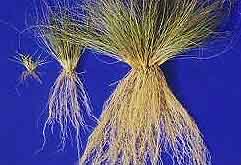 Short grasses have short roots. Vigorous grasses have dense, multi-branched roots that hold soil and reach deep for water and nutrients.
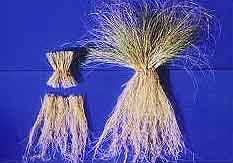 When a grass gets grazed, it prunes its own roots to match the top. These dead roots become new soil.
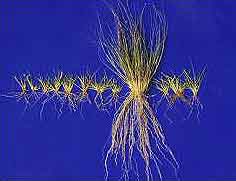 When grazers bite what they like again and again, the less palatable plants gain a competitive advantage for water and nutrients. Article |
Many of the processes most important to ecosystem health happen mainly under the soil surface. These include topsoil building, competition between plants, decay, mineral cycling, and many other important ecosystem functions. But for most people, this aspect of nature is "out of sight, out of mind."
Soil that contains plenty of organic matter from plant decay allows water to penetrate easily, and holds lots of water, yet resists erosion. Minerals and nutrients stay available to plants. Once soil loses its organic matter, people notice yields dropping, fertilizer use increasing, or both. Depleted soil becomes vulnerable to drought, and blows and washes away easily.
Grazing builds soil
The mass of grass roots and their living tops are approximately equal. Roots need energy, which can only come from green leaves. A small top can't make enough food to support big roots.
When a strong, healthy grass gets grazed, it prunes its own roots within a few hours to match the size of its top. These dead roots feed soil organisms and build topsoil. So does the plant top, after the animal turns it into manure.
If the plant gets adequate time to recover completely before it gets grazed again, grazing doesn't hurt it. But when plants get grazed again and again, their tops stay small and so do their roots. Their ability to absorb nutrients may drop by 80-90%. Their shallow roots make them vulnerable to drought. In brittle climates, repeated grazing is often enough to kill plants.
Done right, pulsed grazing (heavy grazing followed by a long recovery period) can build new topsoil amazingly fast -- up to several centimeters per year.
Assessing landscape health beneath the surface
If an area never gets grazed, or gets continuously grazed, we can get a fair of idea of what's happening underground by looking at the size of plants. An area that just got pulse-grazed may have short plants, but be very healthy. Check ecosystem function -- if the area is brittle but you find many plant species closely spaced and plenty of litter, the land is almost certainly in good shape.
When new topsoil is forming rapidly, you'll notice the soil feels light and springy under your feet. It has a composty smell, friable texture, and dark color.
Next: Part 2 -- Landscape diagnosis
Test your understanding on landscapes from around the world.
Updated 31 October 2002